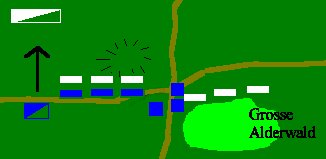 | ||
The Battle of Grosse Alderwurst
Austria, 1809 General Frontenapie rubbed his grumbling belly. Food had been scarce the last few days, due to the lack of time spent on foraging in the Austrian countryside. After the decisive victory over the Austrians at Bad Sausagehausen Frontenapie's little force had been ordered to pursue the fleeing enemy. The fact that the Austrians had not fled but were rather annihilated to a man seemed to be ignored by the French High Command. Obviously L'Empereur had not seen Frontenapie's report. Three days of hard marching later Frontenapie had not met any resistance, but still was ordered forward with all possible speed. His empty belly gurgled unhappily at the latest set of orders. It was a simple encounter battle. Both sides blundered into each other. The French must push through the Austrians as well as inflicting maximum casualties on the enemy. The Austrians are a reconnaisance in force; General Vydal Bäiros was sent out to discover the sudden lack of communication from General von Schlepentoss. General Bäiros elected to stretch his small command out in one long thin line. Having only two regiments of foot, one troop of cavalry and one ineffectual battery of six pounders, Bäiros was worried about his exposed flanks. The horse were deployed to the rear, to form the Austrians' refused right flank. Austrian firepower would stop any French attack it was hoped. The leading elements of General Frontenapie's force, tired as they were from a long exhausting pursuit, resolved to attack the thin Austrian line. Under the watchful eye of their commander, the French formed into a compact block. One regiment shook out into line, which was backed by another regiment composed of battalion attack columns. The French cavalry, weary from scouting, faced their Austrian mounted counterparts. Frontenapie felt confident that the thick woods to his right would suffice to protect that flank. As insurance though, his battery of guns unlimbered on a small hill in front of the woods. The overall plan was simple - push as rapidly as possible to the Austrians, disorder them with musket fire, then unleash the attack columns. Colonel Gligergratz looked at his orders oddly. He squinted his one good eye at the trees in the distance. His other eye had been removed by a French musket ball fragment at Austerlitz a few years ago. That was the story he told at regimental dinners at any rate. The ocular removal actually occurred while Gligergratz was on his knees fumbling under a bed for his dropped snuff box. He grimaced at the memory. The Austrian colonel really hated cats now. Still, one eye was enough to see that his regiment had deployed into line directly in front of a thick tangled forest. His orders assured him that it was merely a hedge. Gligergratz shrugged. An order was an order. He bellowed at his captains to advance. Hopefully Bäiros knew what he was doing. The Austrians and French rapidly marched towards each other. The Austrian left quickly outpaced the centre and reached the edge of the forest facing them. The Austrian centre had slowed down, seeing the French bluecoats bearing directly down on them. Unnerved, the Austrians opened fire. The volley crashed into the French line but did not slow it. A few minutes passed as the lines continued to close, then the French stopped to release their first fire. The Austrians wavered but did not break. Both sides settled down to trade bloody close range volleys. At this point the French cavalry thundered past the smoke wreathed battlefield. The Austrian horse had taken no part in the advance. Still smug with their easy victory over the Austrian mounted Hussars at Bad Sausagehausen the French arrogantly assumed the Austrian Hussars at Grosse Adlerwurst were just as cowardly. They would be swept aside as easily as a few days ago. And once again victory would be due to the French cavalry. The steady French pressure in the centre had pushed the Austrians back, exposing the flanks of their regiment milling around uncertainly in front of the forest. Seizing the fleeting opportunity, General Frontenapie ordered his second regiment to face right and charge the confused Austrians in the flank. The battered French firing line must continue to hold against the Austrian musket fire. Both sides' fire was slackening as casualties mounted. With a roar the French columns bore down on the Austrians. The first battalion was hit simultaneously in the flank by two French battalions and just crumpled in the face of the furious bayonet charge. It was the critical point of the battle. Discover the outcome of this deciding moment.
| ||








